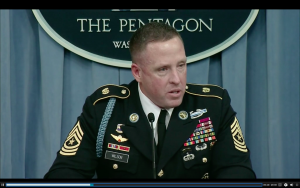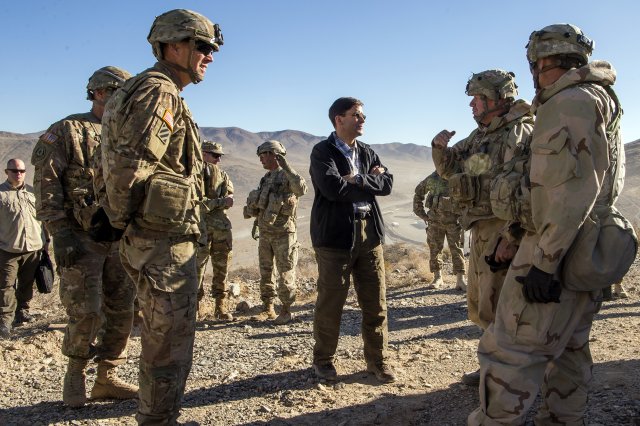Virtual Training Will Save Real Army Lives: Close Combat Task Force
Posted on

Soldiers train with the Dismounted Soldier Training System (DSTS). The Pentagon’s Close Combat Lethality Task Force is looking at the next generation of such VR training systems.
PENTAGON: Of all the technologies and tactics that the defense secretary’s Close Combat Lethality Task Force has looked at, I asked one battle-hardened noncom here this morning, what’s the one thing you personally think has the most potential to save lives? His answer wasn’t a bigger gun or a new drone. Instead, Sgt. Major Jason Wilson said, without a second of hesitation, “the Synthetic Training Environment.” That’s a new combination of virtual reality and real-world data that could revolutionize training for an ancient art — what Wilson called “extreme violence within line of sight of the enemy.”

Jason Wilson, Command Sergeant Major for the Close Combat Lethality Task Force (CCLTF), briefs reporters at the Pentagon
For decades, the US has invested massively in simulators for fighter pilots so they could fight virtual battles over and over before they ever fought a real one, making mistakes and “dying” in practice so they wouldn’t die for real. In actual combat, pilots look through sophisticated Heads-Up Displays (HUDs) that project data directly on their field of view, illuminating threats and targets too distant for the eye to see. Now computer technology has advanced enough, and the former infantryman who’s now Defense Secretary is passionate enough to apply the same technology for foot soldiers so they, too, can “fight 25 bloodless battles” before their first real fight, as Defense Secretary Jim Mattis puts it.
But it’s one thing for a cabinet secretary to create a task force. It’s something different, and very telling, when a 23-year infantry veteran like Wilson thinks a new technology is actually worthwhile.
The technology to create an infantryman’s HUD – which the Army wants to roll out next year – could “revolutionize the way soldiers see, process, and understand the battlespace,” Wilson told reporters this morning, “providing soldiers an unparalleled advantage on the battlefield.” But the immediate pay-off is before battle is joined, he said, “to provide realistic training for our soldiers.”
By superimposing virtual data over a view of the real world, rather like a militarized Google Glass or Pokémon Go, this “augmented reality” technology could help troops navigate cross-country and indicate the location of friendly troops or reported threats. In training, you could overlay virtual enemies and obstacles over the real world, allowing soldiers to train at their home base – jumping, running, and crawling through the dirt the way infantry always have – but replicate the specific conditions they’ll face in real-world missions.

Army Secretary Mark Esper speaks to soldiers at the National Training Center on Fort Irwin, California
But wouldn’t it be better to just send more troops to the Army’s existing Combat Training Centers or the Marine Corps Air-Ground Combat Center, famous for their rigorous training with real equipment against a live Opposing Force (OPFOR)? “Fort Irwin, Fort Polk, 29 Palms, they can only train so many units in a year,” responded Wilson, who’s served at the Fort Polk Joint Readiness Training Center himself. You get better at combat tasks, like anything else, through repetition. “The reps are going to have to happen at home station,” he said, which is where the virtual training is invaluable.
That said, “no matter how much of this training that you can do in the Synthetic Training Environment, you’re not going replace a soldier being behind his weapon…in in the mud,” Wilson said. “(But) before they go out and conduct the training in a live situation, they can actually rehearse it through the virtual.”
This isn’t some solo first-person shooter joyride irrelevant to the tight-knit teams that win real battles, Wilson made clear. “An individual can put it on and immerse himself into that environment, or a squad can put it on and be able to actually conduct training (together),” he said. “It can tie into a platoon, it can tie into a company, it can tie in all the way up to a BCT (Brigade Combat Team). That’s the one we are currently looking at, that we are assessing right now.”
Now, a brigade is several thousand soldiers, so putting all of them in augmented reality goggles and having them interact might be beyond current technology. (The wireless bandwidth required would be staggering). But World Of Warcraft and other Massively Multiplayer Online games can manage such numbers in a simplified, purely virtual environment. It’s also definitely possible to emulate elements of a brigade — fire support, for example — for a squad doing augmented reality training. Wilson didn’t go into these details, so we’re pestering the Pentagon for them. Stay tuned.
Subscribe to our newsletter
Promotions, new products and sales. Directly to your inbox.
